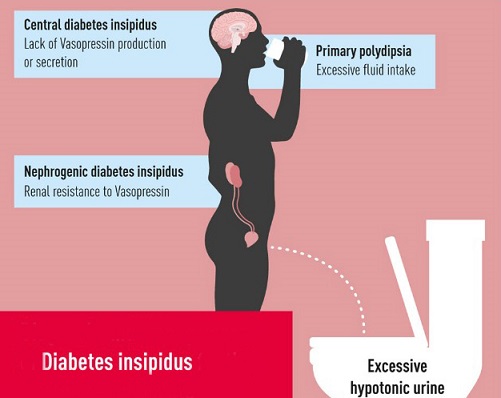COVID-19 News: Italian Doctors Warn That SARS-CoV-2 Can Cause Water Balance Disorders Due To Damage Caused To The Kidneys!
Nikhil Prasad Fact checked by:Thailand Medical News Team Jan 15, 2024 1 year, 11 months, 3 weeks, 3 days, 14 hours, 16 minutes ago
COVID-19 News: The global impact of the COVID-19 pandemic has been multifaceted, revealing a spectrum of symptoms and complications beyond the initial respiratory focus. Recent study findings by Italian doctors have brought attention to an intriguing connection between SARS-CoV-2 and nephrogenic diabetes insipidus (NDI), a water balance disorder affecting the kidneys. This
COVID-19 News report delves deeper into the complexities of this association, exploring the multifactorial etiology of kidney damage induced by SARS-CoV-2 and the emergence of NDI.
 SARS-CoV-2 Causes Nephrogenic Diabetes Insipidus (NDI), a water balance disorder
Nephrogenic Diabetes Insipidus
SARS-CoV-2 Causes Nephrogenic Diabetes Insipidus (NDI), a water balance disorder
Nephrogenic Diabetes Insipidus
Nephrogenic diabetes insipidus is a disorder characterized by an imbalance in water regulation, resulting in excessive urine production (polyuria) and an intense thirst (polydipsia). Typically associated with factors such as lithium therapy, the recent case of a 71-year-old man presents a unique diagnostic challenge due to a history of lithium use and the concurrent impact of SARS-CoV-2 infection.
COVID-19's Impact on the Kidneys
While the primary target of SARS-CoV-2 is the respiratory system, emerging research has shown that various organs, including the kidneys, can be affected, leading to multiorgan dysfunction. Previous studies primarily focused on early segments of the nephron as the primary sites of SARS-CoV-2-induced kidney damage. However, the virus's widespread receptors and molecular release raise concerns about potential effects on distal segments of the nephron.
The presented case study of a geriatric patient revealed the manifestation of diabetes insipidus symptoms about 20 days into hospitalization for severe COVID-19 pneumonia. This suggests that not only the early segments but also the distal segments of the nephron could be affected by the virus. The complexity is further heightened by the patient's history of lithium therapy, adding a layer of intricacy to the diagnostic process.
Distal Nephron as a Vulnerable Target
The study proposes that the collecting duct, a distal segment of the nephron, may serve as a target for SARS-CoV-2 infection. This infection may occur either directly or indirectly, resulting from lesions in the upstream portions of the nephron that cascade into the distal segment. The involvement of molecules beyond angiotensin 2 converting enzyme (ACE2) is also suggested, emphasizing the need for a comprehensive approach to understanding the complexity of SARS-CoV-2 infections.
Exploring COVID-19-Related Renal Damage
Aside from respiratory complications, cases of acute renal injury associated with COVID-19 have been reported. These injuries result from direct and indirect mechanisms, including viral binding to receptors like ACE2, transmembrane serine protease type (TMPRSS2), cathepsin L (CTLS), and cluster of differentiation 147 (CD147). The study highlights the predominantly proximal nephron involvement in COVID-19-related nephropathy, making th
e emergence of nephrogenic diabetes insipidus in this case unusual.
Diabetes Insipidus and SARS-CoV-2 - A Complex Diagnosis
Diabetes insipidus is characterized by excessive urine production and intense thirst, and it can result from deficiencies in antidiuretic hormone (ADH) secretion or renal resistance to ADH activity. The case under consideration demonstrates a significant increase in urine volume and low osmolarity, aligning with the diagnosis of nephrogenic diabetes insipidus. The water deprivation test confirmed the diagnosis, with subsequent treatment involving water supplementation and thiazide introduction.
The Multifactorial Etiology of Kidney Damage
The multifactorial etiology of kidney damage induced by SARS-CoV-2 is underscored, encompassing both direct viral mechanisms and indirect systemic effects. The study delves into the involvement of inflammatory cytokines, thrombotic events, and the renin-angiotensin-aldosterone system in renal damage. Molecular analyses reveal the presence of ACE2, TMPRSS2, CTLS, and CD147 in various portions of the renal tubule, expanding the understanding of potential entry points for the virus.
Lithium Therapy and NDI - Adding Complexity to the Diagnosis
The patient's prior lithium therapy adds complexity to the diagnosis, as chronic lithium use is a known cause of nephrogenic diabetes insipidus. However, the study argues that the chronology of NDI symptoms aligns more with SARS-CoV-2 infection than lithium use. The geriatric patient's ability to access water freely during hospitalization challenges the notion that lithium-induced NDI was the sole culprit.
Considering the Peculiar Geriatric Complexity
The peculiar geriatric complexity of the case requires unraveling aspects often tangled up in the medical and pharmacologic history, as well as the current clinical patient situation. Continuous clinical observation, parametric and laboratory monitoring, and the involvement of family members are deemed mandatory to guide towards a correct diagnosis. This complexity is magnified in the context of SARS-CoV-2 infection and the management of its unexpected complications.
Conclusion - Navigating the Uncharted Waters
In conclusion, the presented case and literature review underscore the intricate interplay between SARS-CoV-2 and kidney damage, emphasizing the need for a comprehensive approach in the diagnosis and management of unexpected complications. The study proposes that the collecting duct may be a receptor target for SARS-CoV-2 in the kidneys, warranting further molecular analyses and autopsy observations.
As the medical community continues to grapple with the complexities of COVID-19, understanding its diverse effects on various organs, including the kidneys, remains crucial for effective patient care and management. The presented case of nephrogenic diabetes insipidus associated with SARS-CoV-2 adds a new dimension to the evolving landscape of COVID-19 complications. It prompts researchers and clinicians to explore the intricate mechanisms underlying the virus's impact on the renal system, with implications for both diagnosis and treatment strategies. The journey through uncharted waters continues, urging the medical community to stay vigilant, adaptive, and collaborative in the pursuit of unraveling the mysteries of COVID-19.
The case study and study findings were published in the peer reviewed journal: Microbiology Society.
https://www.microbiologyresearch.org/content/journal/acmi/10.1099/acmi.0.000598.v3
For the latest
COVID-19 News, keep on logging to Thailand Medical News.
